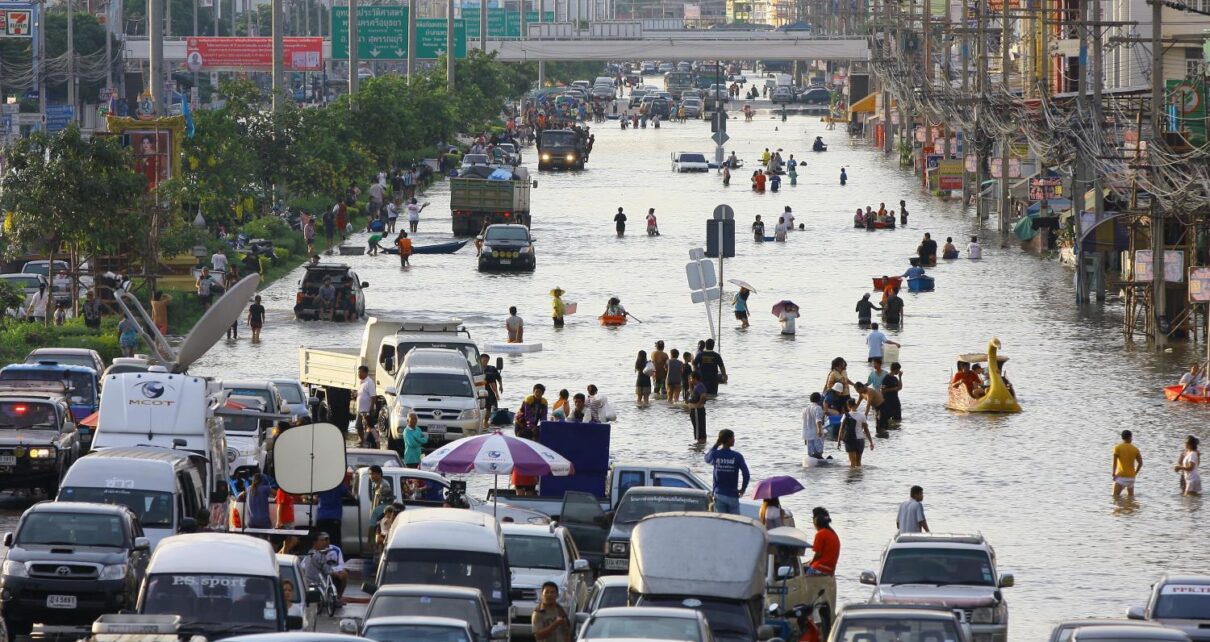In Thailand, floods are not a new ordeal but a persistent one, weaving into the fabric of the nation’s climate, geography, and development path. The catastrophic 2011 floods stand out as a defining moment, yet the pattern of inundation persists into 2025 and beyond. As the country grapples with repeated deluges—from the northern provinces to the capital region—the need for durable, coordinated flood management has never been more urgent. The distance between crisis and resilience remains bridged only by sustained policy reform, ambitious infrastructure, and a governance culture that can integrate long-term planning with local knowledge. This article delves into why flooding recurs in Thailand, what lessons have historically been learned and ignored, and how Thailand might chart a path toward truly integrated, climate-resilient water management.
The flood landscape in Thailand: a long-running challenge
Thailand’s history with flooding is long and layered, marked by seasonal patterns, episodic mega-flood events, and a geography that makes the country inherently vulnerable to water-related hazards. The flooding risk is not limited to remote or rural areas; major urban centers, including Bangkok, have faced severe inundations across decades—most notably in 1938, 1995, and 2011. Provinces across the country have repeatedly experienced major flood events in particular years: 1983, 2000, 2010, 2013, 2014, 2016, 2019, 2024, and 2025, to name a sequence that underscores the frequency of these disasters. These repeated floods illustrate a pattern rather than an anomaly, signaling systemic vulnerabilities that intertwine environmental forces with human development.
The 2011 floods remain etched in national memory as an especially severe episode with far-reaching consequences. The World Bank documented US$46.5 billion in economic losses, amounting to about 1.5 trillion baht, with approximately 13 million people displaced and around 800 lives lost. The economic disruption extended well beyond the immediate disaster zone, affecting Thailand’s industrial heartland for months and disrupting global supply chains reliant on Thai manufacturing and exports. The breadth of impact highlighted how a flood crisis can ripple through regional and international markets, revealing the country’s economic exposure to hydrological extremes. Even decades after that watershed event, the memory of the scale of destruction continues to shape policy discussions, risk assessments, and public expectations regarding future flood responses.
In recent years, Thailand has seen a continuation of flood-related episodes that reinforce the sense of ongoing vulnerability. The floods in Nan in July, Chiang Mai in August, and Phetchabun in September illustrate that inundation is not confined to particular seasons or geographies but can emerge in diverse forms across different regions. Bangkok itself has a long history of flood events, with notable episodes in 1938, 1995, and 2011, reminding residents and policymakers alike that even the nation’s capital is not immune to extreme water events. The cumulative impact of recurring floods—on livelihoods, property, infrastructure, and cultural heritage sites—continues to shape social and economic trajectories, reinforcing the imperative for comprehensive flood management strategies that go beyond episodic relief.
A closer look at the geographic and infrastructural landscape reveals why floods are so prevalent. Thailand sits on a low-lying delta plain with major rivers flowing from north to south, which naturally predisposes large swaths of the country to inundation during periods of heavy rainfall or riverine overflow. Seasonal monsoons and tropical storms bring intense rainfall, and in some years, these rains are intensified by typhoon activity that traverses the western Pacific and interacts with the Thai monsoon system. Urbanization, rapid population growth, and land-use changes have compounded the risk by reducing natural drainage capacity, converting wetlands into developed land, and increasing surface runoff. Land subsidence—particularly in Bangkok and adjacent provinces—has further lowered elevations and stressed drainage systems. The urban fabric itself, with densely built areas and insufficient planning for flood routes, frequently blocks natural drainage corridors and exacerbates water accumulation.
Beyond natural drivers, human-made factors—such as the degradation of wetlands, the clogging of canals (klongs) with waste, and aging or insufficient drainage and flood-control infrastructure—play a decisive role in flood severity and duration. Inadequate maintenance of dikes, embankments, and floodways can leave communities exposed during peak rain events. The management of rivers and waterways—an essential component of flood risk reduction—often struggles with governance fragmentation, overlapping jurisdictions, and delayed decision-making. As climate change intensifies rainfall patterns and sea-level rise, the vulnerability embedded in infrastructure and governance systems becomes more acute. In short, the Thai flood challenge results from a confluence of natural hydrological forces and human-scale vulnerabilities that require a holistic, cross-sectoral response.
Economic considerations are central to understanding the flood problem as well. Direct damages from floods are accompanied by broader costs, including interruptions to manufacturing, logistics, and trade, which in turn affect investment confidence and long-term growth. Cultural heritage sites, including temples and historical landmarks, face recurring threats from floodwater and moisture. UNESCO has flagged concerns about flood risks to Thailand’s temples, palaces, and historic remains, including those in Ayutthaya, underscoring the stakes beyond mere economic calculations. The combination of direct losses, long-term asset degradation, and reputational risk makes flood risk management a critical issue for policy designers, urban planners, and national development strategies alike.
In this broader context, the ongoing flood narrative in Thailand emerges as a composite of climate vulnerability, topographic predisposition, development choices, and governance capacity. The pattern of recurrent floods—intertwined with monsoons, rain events, subsidence, urban expansion, and waterway management challenges—demands an integrated strategy that aligns engineering, policy reform, community engagement, and climate adaptation. The trajectory from 2011 to 2025 reveals both the scale of the challenge and the persistent gaps in translating lessons into durable, systemic changes. As Thailand seeks to reduce the public health, economic, and cultural costs of floods, the focus must shift from reactive responses to proactive, comprehensive planning that addresses the full spectrum of drivers behind this enduring risk.
Why floods happen so often: the set of interlocking drivers
Thailand’s recurrent floods arise from a combination of natural endowments and human choices that together produce a persistent hazard. To understand the problem in depth, it is essential to separate and examine the main drivers: geography and climate, land subsidence, urbanization and land use, deforestation, waterway management, infrastructure inadequacies, governance challenges, and climate change. Each factor contributes in a different way and to varying degrees across regions and timeframes, yet together they create a system that remains highly susceptible to flood events.
Geography and climate lie at the core of Thailand’s flood vulnerability. The country’s location on a broad, low-lying delta plain means that large portions of the territory sit at modest elevations relative to sea level. The major rivers—running north to south—act as conduits for seasonal floods, delivering heavy runoff during the wetter months and seasonally elevated water levels that can overwhelm drainage capacity. Seasonal monsoons compound this risk, delivering heavy downpours that concentrate in short periods, while tropical storms and typhoons from the Pacific can intensify rainfall totals and run-off patterns. The combined effect is a hydrological system that can rapidly transition from normal to extreme flood conditions, particularly in years with persistent rainfall or unusual storm tracks.
Land subsidence amplifies flood risk by progressively lowering the land surface, especially in urban centers such as Bangkok and neighboring provinces. Substantial ground movement reduces elevation margins over time and undermines drainage gradients, making it harder for water to flow away from populated zones. When subsidence aligns with high rainfall events and riverine surges, floodwaters can stagnate more quickly, clogging drainage networks and prolonging inundation. Subsidence also interacts with saltwater intrusion and groundwater management challenges, complicating urban resilience strategies.
Urbanisation and land-use change represent another crucial dimension. Rapid, often poorly planned expansion into floodplains, along riverbanks, and into wetlands reduces natural flood storage capacity and disrupts drainage corridors. Paved surfaces with high imperviousness prevent infiltration, increasing surface runoff during storms. Wetlands that historically absorbed and attenuated flood peaks are diminished, reducing the landscape’s ability to dampen flood waves. As urban areas expand, the need for effective stormwater management, drainage planning, and green infrastructure becomes more urgent, yet these require long-term vision and sustained investment.
Deforestation and reductions in forest cover degrade the landscape’s natural capacity to control runoff and protect soil integrity. Forests and other vegetative cover play a critical role in reducing surface runoff, moderating soil erosion, and aiding water infiltration. When forests are cleared or degraded for agriculture, settlements, or development projects, soils become more prone to erosion, sedimentation in rivers increases, and watercourses become more prone to clogging and flooding downstream. Reforestation and the preservation of watershed buffers can help restore some resilience, but such measures depend on political will, land-use planning, and enforcement.
Waterway management—encompassing both canals (klongs) and rivers—often suffers from under-maintenance and inadequate governance. Canals and rivers serve as key drainage routes during floods, but their capacity is compromised when they are clogged with waste, silted due to sediment deposition, or neglected in terms of dredging and clearance of blockages. In some cases, waterway networks are not aligned with modern urban drainage systems, leading to bottlenecks that intensify flood impacts in downstream or low-lying areas. Effective waterway management requires regular maintenance, efficient sediment management, and synchronized operations with other flood-control infrastructure.
Infrastructure deficits are a persistent driver of flood vulnerability. Dikes, embankments, floodwalls, and drainage systems may be aged, undersized, or poorly maintained, making them ill-equipped to handle extreme rainfall or overtopping events. Large-scale flood defenses and reservoirs are expensive and often take years to build or upgrade, leaving communities exposed in the interim. The mismatch between infrastructure capacity and the scale of frequent deluges raises questions about policy prioritization, financing, and project delivery timelines. The absence of adaptive, climate-resilient infrastructure—designed to cope with rising sea levels, higher rainfall intensity, and longer flood durations—further compounds risk.
Governance challenges lie at the heart of persistent flood vulnerability. Thailand’s water and disaster management landscape features multiple agencies with overlapping mandates, insufficient coordination, and periodic political influence that can derail long-term planning. The Royal Irrigation Department (RID), the Department of Water Resources (DWR), and the Department of Disaster Prevention and Mitigation (DDPM) are among the principal bodies responsible for flood management, yet fragmentation undermines accountability and shared strategy development. New bodies, such as the Office of Water Resources Management (OWRM) and the National Disaster Management Center (NDMC), have been created to bolster coordination, but substantial fragmentation and a top-down tendency continue to impede the integration of local knowledge and community-based approaches. Short election cycles can incentivize policymakers to prioritize near-term visibility over multi-decade strategies, delaying essential reforms and capital investments.
Climate change intensifies all these drivers by altering precipitation patterns, increasing the probability of extreme rainfall events, and contributing to higher sea levels. A warming climate can shift the intensity and duration of monsoon seasons, creating scenarios in which flood peaks become more severe or prolonged. Coastal and riverine regions face amplified risk as storm surges and higher sea levels interact with inland floodwaters. The cumulative effect is a system that demands forward-looking adaptation measures, including resilient infrastructure, revised land-use policies, and proactive disaster planning, to anticipate and mitigate changing risk profiles.
The 2011 wake-up call: lessons learned and the road to reform
The 2011 floods functioned as a watershed moment for Thailand, revealing both the scale of vulnerability and the gaps in preparedness. Months before the catastrophic inundation, a team of Dutch flood-management experts warned of Thailand’s high risk of catastrophic flooding within a few years. Their forecast proved prescient when a deluge of unprecedented magnitude overwhelmed large portions of the country, submerging industrial zones and triggering widespread economic disruption. The Dutch have long been recognized as leaders in flood management due to their own historical experiences with flooding and their advanced engineering and policy approaches. Their warning underscored a global lesson: that flood risk is not solely a matter of hydraulic defense but a problem of integrated governance, long-term planning, and community engagement.
In the years that followed, there were promises of reform and ambitious flood-defense plans designed to strengthen resilience and reduce vulnerability. However, progress did not keep pace with the scale of the threat. Large-scale projects frequently stalled at the planning stage, hampered by cost concerns, political contention, or a lack of consensus among stakeholders. A notable example was the megaproject proposed by then-Science and Technology Minister Plodprasop Suraswadi in 2011—an ambitious, grand vision that aimed to transform flood management nationwide but ultimately did not come to fruition in the expected timeline. The disjunction between planning and implementation left communities exposed to ongoing flood risk and left policy-makers seeking more durable, executable reforms.
The persistent gap between rhetoric and results also reflects a broader governance dynamic: the challenge of translating high-level ambitions into concrete, on-the-ground action. While post-2011 reforms introduced new structures and some integration mechanisms, the reality of fragmented authority, variable funding, and political incentives that favor short-term gains over long-term resilience continues to hinder decisive progress. The 2011 event thus stands not only as a historical rainfall record but as a cautionary tale about the need for sustained political commitment, cross-sector coordination, and a system-wide approach to flood risk that aligns infrastructure, governance, community resilience, and climate adaptation.
Attitudes toward flooding: cultural norms, economic realities, and social dynamics
Public perception of floods in Thailand is varied and complex, shaped by cultural norms, lived experience, and economic realities. For many communities deeply exposed to seasonal or episodic flooding, floods are sometimes perceived as an inescapable cycle—an aspect of life that requires adaptation rather than prevention. As one resident illustrated, for example, when floods arrive, households may move furniture upstairs, wait for waters to recede, and then resume daily life with a sense of resilience cultivated through repeated exposure. Such attitudes can dampen the perceived urgency around costly preventive measures, especially when the immediate personal or community costs of mitigation are high and benefits are diffuse or long-term.
That said, others recognize potential benefits in certain flood regimes. In provinces along the Mekong and its tributaries, farmers and fishermen note that seasonal floods can replenish fisheries and enrich agricultural land. This cultural and economic nuance highlights how floodwaters can contribute to livelihoods in particular contexts, complicating the push for aggressive flood-prevention strategies. The challenge for policy-makers is to balance respect for traditional knowledge, local livelihoods, and cultural practices with the imperative to reduce risk and protect long-term economic stability. The existence of practical benefits does not negate the dangers and damages associated with floods, but it does demand thoughtful, participatory approaches that co-create risk-reduction strategies with communities rather than imposing top-down solutions that may be viewed as external or misaligned with local realities.
From an economic perspective, the recurrent nature of flooding erodes investor confidence, disrupts infrastructure, and threatens cultural and historical assets. The disruption to supply chains, manufacturing sectors, and transport networks can ripple through regional economies, raising the costs of goods, delaying projects, and dampening growth prospects. UNESCO’s concerns about flood risks to temples, palaces, and historic remains—such as those in Ayutthaya—underscore the broader cultural stakes at play. When cultural heritage sites face repeated flood exposure, the long-term value of these assets and the economic benefits they generate in terms of tourism, education, and national memory come under threat. The social dimension—displacement, migration patterns, and changes in household income—adds another layer of complexity to flood governance, illustrating why flood risk reduction must be integrated with social protection, land-use planning, and economic development strategies.
Policy shortcomings and governance: why reform remains challenging
The governance landscape for water and disaster management in Thailand features multiple agencies and a web of overlapping responsibilities. The Royal Irrigation Department (RID), the Department of Water Resources (DWR), and the Department of Disaster Prevention and Mitigation (DDPM) are central actors in flood management, yet coordination among them is often insufficient and inconsistent. Fragmentation leads to duplication in some areas and gaps in others, undermining accountability and the ability to implement coherent, cross-cutting strategies. The creation of new bodies, including the Office of Water Resources Management (OWRM) and the National Disaster Management Center (NDMC), was intended to strengthen coordination and streamline decision-making. In practice, however, fragmentation persists, and the government tends to favor top-down policies that may neglect local knowledge and community-based approaches that can be more effective in certain contexts.
A recurring policy challenge is the tension between short-term political cycles and the long-term nature of flood-prevention investments. Politicians and policymakers often face electoral incentives that reward immediate results within a few years, whereas robust flood management requires sustained funding, commitment, and planning that span decades. This mismatch can slow decision-making, hinder the scaling of successful pilots, and reduce the probability that essential but expensive infrastructural projects reach completion. As a result, even when there are clear warnings and credible analyses, the transition from thoughtful proposals to implemented programs can be protracted, leaving communities exposed to ongoing flood risk.
Despite these governance challenges, the Thai government has recognized the need for deeper integration of water resources management and disaster risk reduction. The introduction of coordinated planning bodies and the emphasis on cross-agency collaboration signal an understanding that isolated, siloed approaches are insufficient to address flood risk comprehensively. The next step is to translate that understanding into concrete reforms: clearly defined mandates, streamlined authority, transparent accountability mechanisms, and sustained funding that supports multi-decade investments. The success of such reforms will depend on political will, stakeholder buy-in, and the ability to translate national-level strategies into localized action that aligns with community needs and capacities.
Lessons from abroad: what other nations teach Thailand
Thailand does not stand alone in facing flood management challenges. Several countries have advanced integrated, long-term water-management strategies that combine engineering with institutional reform, public participation, and climate adaptation. The Netherlands, recognized globally for its sophisticated flood-risk governance and infrastructure, has demonstrated how a country with a high flood exposure can develop resilient systems through a combination of engineering, spatial planning, and proactive governance. German and Dutch experiences emphasize that successful flood management goes beyond building dikes or drains; it requires a holistic framework that fuses technical solutions with governance reforms, stakeholder engagement, and adaptive planning for climate change.
A notable example draws from the Rhine Cities Union, where local governments along the Rhine collaborate annually to share experiences, coordinate flood-protection projects, and integrate public input into decision-making. This approach centers on cooperation, capacity-building, and long-term vision, delivering a practical blueprint for cross-border and cross-jurisdiction collaboration. Thailand can take inspiration from such models by adopting formal mechanisms for multi-stakeholder engagement, cross-agency coordination, and shared decision-making that incorporate public input, scientific data, and local knowledge. The core lesson is that sustainable flood management is not a one-off investment in infrastructure; it is an ongoing process of institutional reform, public education, and climate-adaptive planning that evolves with changing risk profiles.
International experience also demonstrates that an overreliance on engineering solutions is insufficient. Real-world outcomes show that successful flood management requires integrated strategies that include institutional reform, stakeholder participation, robust data and monitoring systems, and proactive climate adaptation planning. The combination of structural measures—such as levees, reservoirs, and drainage networks—with non-structural measures—such as land-use planning, early warning systems, community-based preparedness, insurance mechanisms, and water-pricing strategies—tends to produce more resilient outcomes. For Thailand, the challenge is to adapt these lessons to national realities: a federal of agencies, diverse regional needs, and political dynamics that can either hinder or help the course of reform.
Possible solutions: building a comprehensive, long-term flood resilience
To break the cycle of recurring floods, Thailand will need to implement a set of bold, long-term interventions that are integrated across sectors, scales, and governance levels. The following priorities outline a comprehensive strategy that combines structural investments with policy reform, community engagement, and climate adaptation.
Integrated Water Management: The core of the proposed approach is integrated management of water resources across agencies and levels of government. This means establishing clear accountability frameworks, aligning goals across RID, DWR, DDPM, and other relevant bodies, and ensuring that planning processes reflect shared objectives for flood risk reduction, water security, and climate resilience. A unified platform for data collection, model sharing, and scenario planning would enable more accurate risk assessments and better-informed decisions about where and when to deploy interventions.
Infrastructure Investment: Investments should focus on modernizing and expanding flood-control infrastructure, including dikes, embankments, drainage systems, reservoirs, and floodways. Emphasis should be placed on resilience against rising sea levels, increased rainfall intensity, and longer flood durations. Infrastructure plans must incorporate climate projections and be adaptable to evolving risk profiles. Modern technology—such as real-time drainage management, automated gates, and sensor networks—can optimize the performance of defenses and reduce flood duration.
Land Use Reform: Land-use planning must prioritize flood risk reduction by enforcing zoning laws that restrict development in high-risk zones and protect wetland areas that act as natural buffers. Protecting and restoring wetlands, floodplains, and natural drainage corridors is essential, as is preventing risky construction in sensitive waterways. A forward-looking land-use policy should align with river basin management and water-resource planning to reduce vulnerability and improve ecological resilience.
Community Engagement: Community involvement is critical for building resilience. This includes participatory planning with local stakeholders, education programs on flood preparedness, and the establishment of community-based maintenance and response mechanisms. Involving residents in early-warning systems, evacuation planning, and post-flood recovery efforts fosters ownership and enhances the effectiveness of preventive measures. Local knowledge and practical insights can improve the design and placement of interventions, ensuring they are appropriate for specific communities.
Climate Adaptation: Policies must anticipate the realities of climate change, including rising sea levels and more intense storms. Climate-adaptation planning should be integrated into national and local development plans, with explicit targets for reducing vulnerability and increasing resilience. This requires the incorporation of climate projections into infrastructure design, land-use planning, and disaster-response strategies, as well as ongoing monitoring to adjust policies as conditions evolve.
Financing Mechanisms: Ensuring sustainable funding for long-term flood-management programs is critical. Innovative financing tools—such as water taxes, insurance schemes, resilience bonds, and public-private partnerships—can secure the capital required for multi-decade investments. A dedicated funding framework, possibly backed by international development support and climate finance, could provide the financial stability necessary to implement and maintain resilient systems over the long term.
Operationalizing this vision demands political will, stakeholder collaboration, and a shift in public mindset toward valuing long-term resilience over short-term political gain. It also requires breaking down governance silos, aligning incentives across agencies, and creating mechanisms that translate national-level commitments into local action. While the path to reform is not simple, the combination of integrated management, infrastructure modernization, land-use reform, community engagement, climate adaptation, and sustainable financing offers a comprehensive framework for transforming Thailand’s flood management from a reactive emergency discipline into a proactive, resilient system.
Conclusion
Thailand’s recurrent flood challenges stem from a confluence of natural endowments, development choices, and governance gaps that collectively produce a high-risk hydrological environment. The 2011 floods were a stark reminder of the vulnerabilities embedded in the country’s economic and social fabric, and the floods of 2025 and beyond illustrate that the risk remains as material as ever. To move from episodic response to durable resilience, Thailand must embrace a holistic, long-term approach that integrates engineering with governance reform, community involvement, and climate adaptation. The lessons from global experience—especially from nations that combine structural defenses with strong institutions and inclusive planning—offer a practical blueprint for reform. Achieving this vision will require sustained political commitment, adequate funding, and a willingness to learn from communities on the ground, whose everyday experiences reveal the true scale of the flood challenge and the pathways to a safer, more resilient future.



